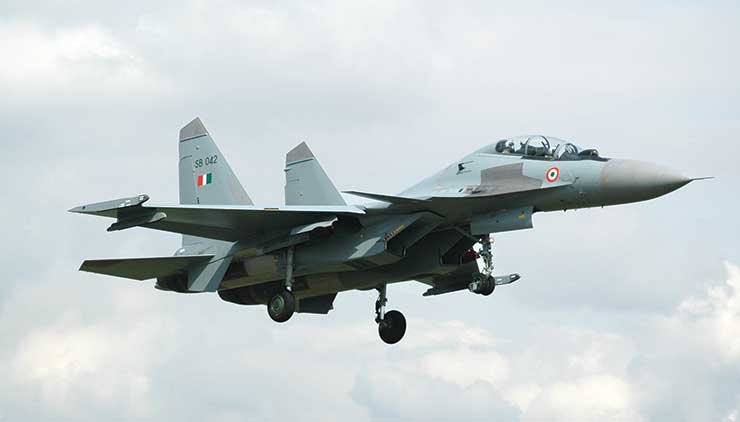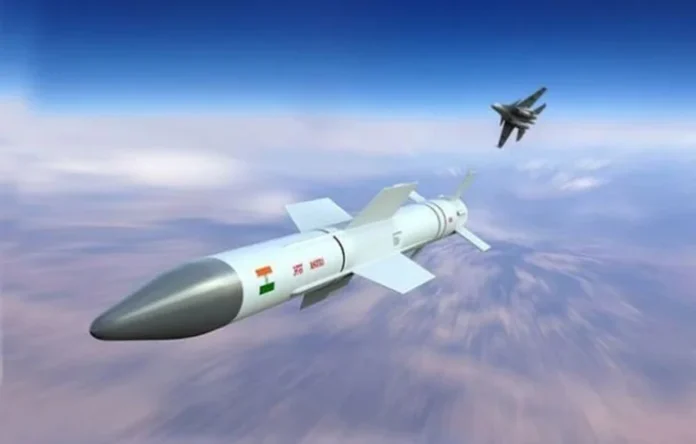For bringing an end to decades old dependency of India on French and Russian-made air-to-air missiles (AAM), the Indian defence and security establishment has braced itself for testing the indigenously developed Astra Mk 2 missile which is equipped with a range of 160 km.
The Defence Ministry, a few days back, announced the signing of a deal worth Rs 2,971 crores for Astra Mk 1 Beyond Visual Range (BVR) and associated equipment. A beyond-visual-range missile is an air-to-air missile (BVRAAM) which has the capability of engaging at ranges 20 nmi ( 37Kms) and beyond.
The above-cited weapon is being procured from Bharat Dynamics Limited (BDL) and shall be used by the Indian Navy and the Indian Air Force.
According to open sources, the Astra Mark 1 would stand as the first such indigenous missile to enter the tri-services of Indian defence that has remained depended on French air-to-air missiles like Meteor and Mica and Russian missiles like the R73 and R 77.
Media reports claim that over 200 missiles have been ordered, although the defence establishment has not yet revealed the exact figure. The missile will cater to the MIG-29k of the Indian Navy and the Sukhoi Su-30 MKI of the IAF. The intention is to incorporate the missile with the MIG-29 of IAF along with LCA Tejas Mk 1 in a phased manner.
𝗔𝗦𝗧𝗥𝗔 𝗠𝗔𝗥K 1 𝗔𝗡D 2
Currently, Astra Mark 1 has a range of around 110 km while experts say that the next generation version, which will have a range of 160 km, shall prove to be a game changer. The missile, developed by DRDO, has a maximum speed of Mach 4.5 that is 5,500 km per hour and each missile costs around Rs 7 to 8 crore.
On the other hand, the Mark 2 variant, which is expected soon, will bring back India’s air-to-air combat superiority over Pakistan. For extending the range, the DRDO has developed a dual-pulse rocket motor for the Astra mark 2.
𝗧𝗛𝗘 𝗕𝗔𝗖𝗞𝗦𝗧𝗢𝗥𝗬
During the Kargil battle in 1999, the Indian Air Force had an advantage over its Pakistani counterparts but lost it nearly a decade ago after the longer range American AMRAAM was deployed.
On February 28, 2020, the then Indian Air Force Chief Air Chief Marshal RKS Bhadauria stated that the Air Force was focusing at regaining an upper hand in air to air missile capability which was allowed to slip, in the middle of a struggle for acquiring missiles in a process that nearly lasted for 15 years.
The IAF chief was referring to the Meteor missiles which are European-manufactured and have a range of about 150 km. As of now, these missiles are on board the Rafale jets. However, the intention to get them integrated with other fighters went down as the cost was high, with a single missile costing around Rs 25 crore.
The MoD states that Astra is economically and technology superior to several imported missile systems and shall provide the Indian fighter jets with a definite edge over the Pakistan Air Force and the PLA Air Force
Apart from this, the IAF was told by the European-manufacturer of the missile, MBDA, that the Russian Su-30 MKI and the French-made Mirage 2000 would not be suitable for the weapon as the radars equipped by these fighters would not be favourable for the missile’s capability.
However, MBDA said that the missile could be integrated on Tejas only if the fighter gets the indigenous AESA radar onboard instead of the Israeli one that will be initially used. Following this, a decision was taken by the IAF to rely on better versions of Israeli I-Derby and Astra for its main firepower and restrict the Meteor missile to the Rafale.
𝗛𝗢𝗪 𝗜𝗦 𝗔𝗦𝗧𝗥𝗔 𝗠𝗞-1 𝗔 𝗚𝗥𝗘𝗔𝗧 𝗗𝗘𝗔𝗟?
Induction of the weapon would serve with a large standoff range to Indian fighters which can thereby neutralise the adversary’s jets without exposing itself to air defence measures.
The weapon will also contribute to reducing India’s dependency on foreign sources. Only a handful of missile builders in China, Russia, Europe and the United States have mastered technologies that contribute to BVRAAMS and now, India has also coined its name in that elite group.
The MoD states that Astra is economically and technology superior to several imported missile systems and shall provide the Indian fighter jets with a definite edge over the Pakistan Air Force and the PLA Air Force.
The PLAAF inducted China’s PL-15 BVRAAM four years ago but reports suggest that Astra is operationally superior to it. Therefore, the Astra Mk-1 is a huge benefit to India, at a time when the country has strained ties with both Pakistan and China and there’s a threat looming.

𝗧𝗘𝗦𝗧𝗦 𝗜𝗡 𝗣𝗜𝗣𝗘𝗟𝗜𝗡𝗘
About a month ago, it was reported that India would be testing various indigenously developed advanced weapons ranging from anti-radiation missiles to smart anti-airfield weapons air-to-air missiles and long-range glide bombs.
Even testing of the Rudram-1 NGARM was announced which is meant to damage several enemy communication, surveillance and radar targets on the ground at a 150-km range after being fired from fighter jets.
Rudram is the first anti-radiation missile indigenously developed by the country and is integrated with the Sukhoi Su-30 MKI which stands as its primary test platform but the weapon can be used with HAL Tejas Mark 1 and 2, SEPECAT Jaguar and the Dassault Mirage 2000, in the future. The weapon is powered by a dual-pulsed solid rocket motor developed by Premier Explosives Limited, and makes use of a Pre-fragmented warhead with optical proximity fuze. A variable trust within a range of 0.6 to Mach 2 is produced by the dual-pulsed solid rocket motor that contributes in reducing the overall reaction time while widening the targeting envelope
Rudram 2 is also being developed with a 350 km range while Rudram 3 would have 550 km range. They would also be equipped with INS-GPS navigation with a passive homing head for the final attack.
Testing of smart anti-airfield weapons (SAAW) are also in the pipeline. These precision-guided bombs are designed to destroy enemy radars, bunkers, aircraft hangers, runways and other reinforced structures at a range of 100-km.
According to a defence official, “ These are 125-Kg Glide bombs, based on two configurations of either satellite navigation or electro-optical imaging infra-red seeker (𝐸𝑂𝐼𝐼𝑅), carried on racks in fighters like Sukhois or Jaguars. A single Sukhoi can carry 32 such bombs. Separately, 1000 –Kg heavy caliber Glide bombs , with a 80 Km range are also being developed.”
– The writer is an Aerospace and Defence Analyst & Director ADD Engineering Components (India) Pvt Ltd (An Indo- German Company). The views expressed are of the author and do not necessarily reflect the views of Raksha Anirveda
-The author is a Defence, Aerospace & Political Analyst based in Bengaluru. He is also Director of ADD Engineering Components, India, Pvt. Ltd, a subsidiary of ADD Engineering GmbH, Germany. You can reach him at: girishlinganna@gmail.com. The views expressed are personal and do not necessarily carry the views of Raksha Anirveda






